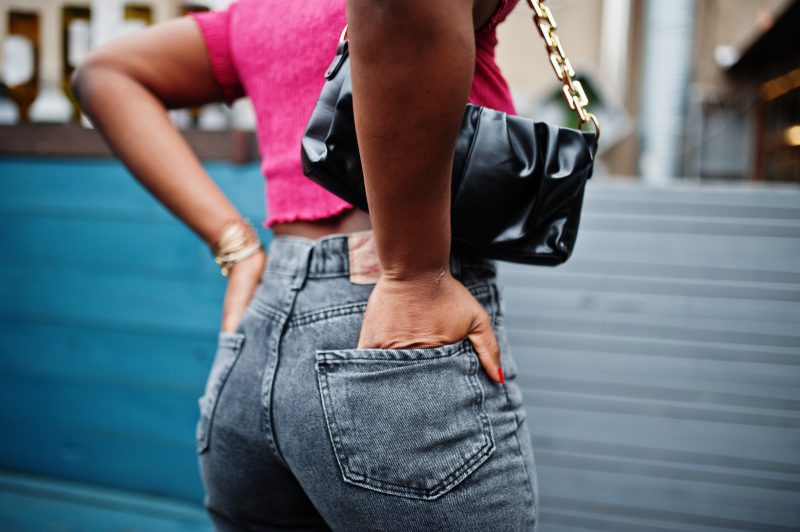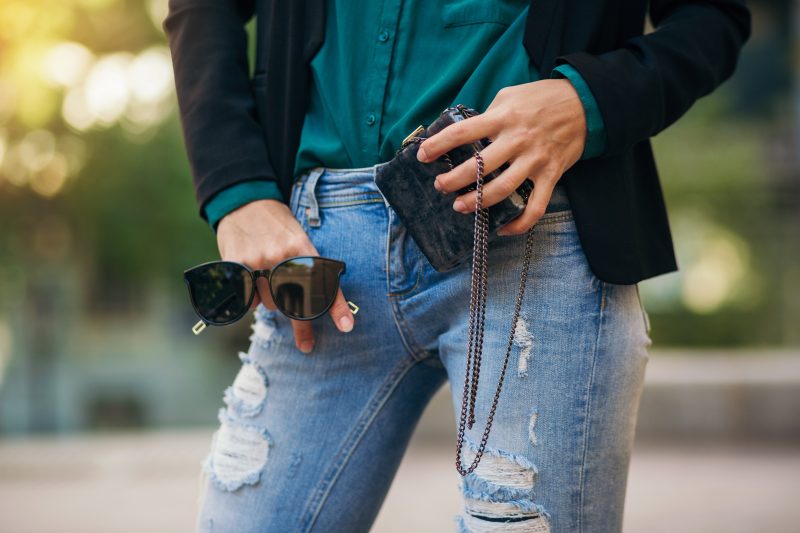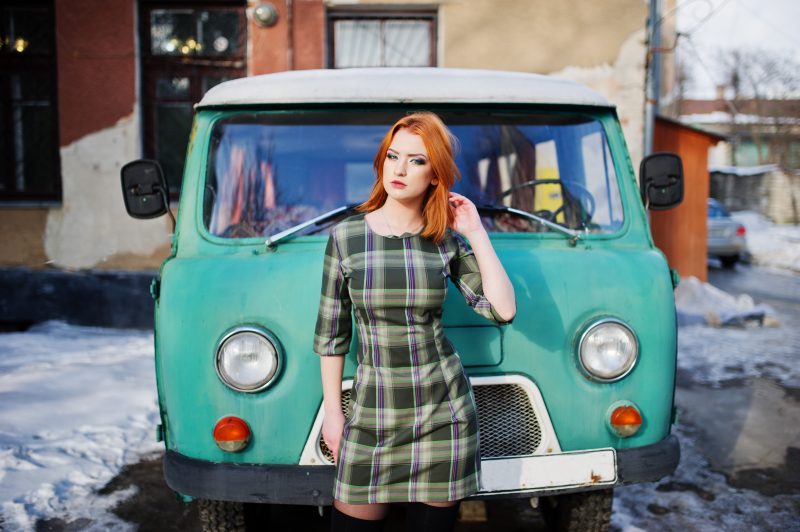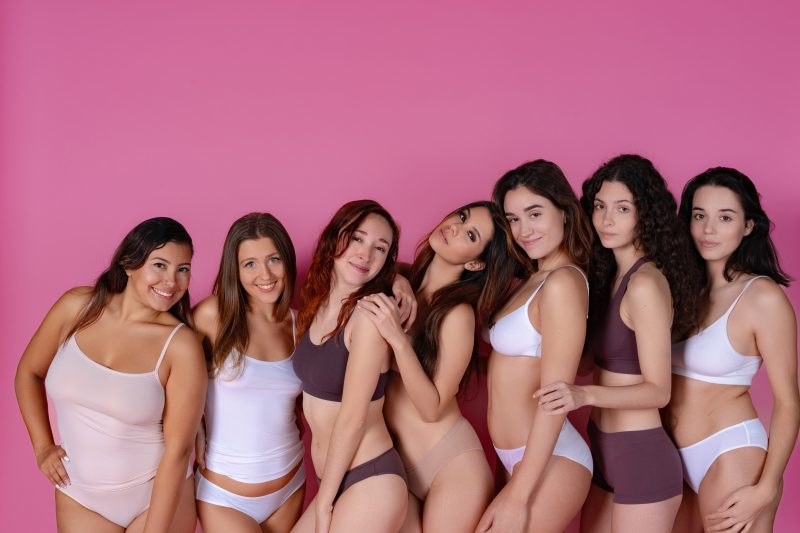I’ve been lied to by the internet more times than I care to admit. That “miracle” hair product that was supposed to give me Timothée Chalamet waves but instead left me looking like I’d been electrocuted. The viral pasta recipe that had my smoke alarm going off at 2 AM while my downstairs neighbor banged on her ceiling with a broom. And don’t even get me started on dating profiles. But the worst betrayals always come from clothing—specifically jeans that promise the moon and deliver something closer to a deflated beach ball.
You know the routine: you see a pair online with hundreds of glowing reviews. “These changed my life!” declares SummerGirl28. “My butt looks amazing and they’re so comfortable I forgot I was wearing pants!” insists FashionMama45. The photos show them fitting like a dream on people with your exact body type (or so you think). You order them with that fluttery hope that maybe—just maybe—these will be The Ones. Then they arrive, you wrestle them up your legs, and… nope. Either they gap at the waist while strangling your thighs, or they fit in the waist but create that weird horizontal line across your hips that makes you look like you’re made of Lego pieces, or they do that awful thing where they flatten your butt into what my friend Emma calls “pancake ass syndrome.”
So when my Instagram algorithm started bombarding me with ads for Bowery Jean Co.’s “Perfect ’93” jeans—complete with promises that they “fit every body type” and “feel like sweatpants but look like designer denim”—my skepticism was at DefCon 5. The comment section was filled with the usual suspiciously enthusiastic praise, including the ultimate red flag: multiple people claiming these jeans “literally changed my life.” Unless these pants are paying off my student loans or making my morning train arrive on time, I’m pretty sure they’re not life-changing.
But after seeing them for the twelfth time in one scrolling session (the algorithm really wanted me to buy these pants), I noticed something interesting. The comments weren’t just the typical “love these!” variety. People were getting specific. Really specific. “These are the only jeans that don’t gap at my waist when I sit down.” “I have 28″ thighs and a 26″ waist and NOTHING ever fits right except these.”
“I’m 5’2″ and the petite length actually hits at my ankle instead of dragging on the floor.” These weren’t vague endorsements—they were solving very particular denim problems that I happened to share.
Plus, they had that slightly vintage straight-leg silhouette that’s neither skinny (officially millennial territory now) nor so wide-leg that I’d look like I was wearing denim culottes (a look that, despite my best efforts, I cannot pull off without looking like I’m playing dress-up in my cooler friend’s clothes). The “high rise but not all the way to your armpits” waist height was exactly what I prefer. And while $148 isn’t cheap, it’s not astronomical by good denim standards.
I decided to conduct a journalistic investigation. For science. And by “science,” I mean “my own curiosity and the permanent denim-shaped hole in my bank account.” But I wasn’t going to do this halfway. To really test if these jeans lived up to their “fits everyone” hype, I needed more bodies than just mine. So I enlisted four friends with wildly different body types to join my denim experiment: Emma (5’10” with proportionately long legs), Jade (curvy with a significant waist-to-hip ratio), Tyler (male but prefers the fit of women’s jeans), and Ava (petite at 5’2″ and athletic).

The ordering process itself revealed the first promising sign: extended sizing from 23-37, three length options (petite, regular, and tall), and—most impressively—the option to order different waist and hip sizes. This last feature almost made me emotional. As someone with what my grandmother delicately called “child-bearing hips” paired with a relatively smaller waist, standard sizing has always been my nemesis. Either the waist fits and I can’t get them over my thighs, or they fit my thighs but I could fit a small family of raccoons in the waistband gap.
When five boxes arrived at my apartment, my super gave me that judgmental look he reserves for my most excessive shopping moments. “More clothes, Miss Harper?” he asked, helping me carry them upstairs. “It’s research, Manny,” I replied with as much dignity as one can muster while defending a massive denim purchase. “I’m doing it for the people.” He wasn’t convinced.
First impression out of the box: the denim had that perfect medium weight that’s increasingly hard to find in this era of stretch-everything. Not too rigid (I’m not looking to reenact that scene from “The Sisterhood of the Traveling Pants” where they have to lie down on the bed and use pliers to zip up), but substantial enough to feel like real jeans. The wash was exactly as advertised—a perfectly faded medium blue that looked like it had been broken in just the right amount without veering into distressed territory. So far, so good.
Then came the real test: actually putting them on. I’m going to be honest—I held my breath as I pulled them up. There’s that moment with every pair of jeans where you know, even before they’re all the way on, whether they’re going to work or not. It’s like a sixth sense you develop after years of denim disappointment. And these… slid right up with no struggle, fastened without requiring contortionist moves, and—most shockingly—actually fit both my waist and thighs simultaneously. I did a tentative squat, prepared for that awful tightening across the thighs. Nothing. I could move freely. I sat down, bracing for the waistband to gap or dig in painfully. Neither happened.
Standing in front of my bedroom mirror (which I’ve angled slightly to be more flattering because I’m not a masochist), I had to admit these looked good. Really good. The straight leg was relaxed without being baggy, the high rise hit at exactly the right point on my natural waist, and—the true test of any good jean—my butt looked like I’d been doing squats daily instead of just thinking about maybe starting a workout routine someday.
But this wasn’t about me. This was science, remember? I needed more data points. I grabbed my phone and started texting the others.
Emma texted back first with a photo of herself in the tall length: “WHAT IS THIS WITCHCRAFT?” The jeans actually hit her at the ankle instead of floating awkwardly mid-calf. For context, Emma routinely has to shop in specialty tall shops or men’s departments to find pants that don’t look like she’s expecting a flood. “I’m wearing these to dinner tonight and if anyone compliments them I’m not sharing the brand name because I want them all for myself,” she added selfishly.
Jade was more measured in her response: “They’re… pretty good actually. No waist gap!” Coming from Jade, whose waist-to-hip ratio usually means she has to get everything tailored, this was essentially a rave review. She did note that she had to do the “jean dance” (you know the one—where you wiggle and jump a little to get them up over your hips) but once on, they fit perfectly.
Tyler’s response was simply a mirror selfie with “DUDE” written across it, which in Tyler-speak translates to enthusiastic approval. Later he called to elaborate: “They don’t pull weird across the front like most women’s jeans do on me, but they still give me the fit I want. I’m buying three more pairs immediately.”
The most surprising feedback came from Ava, who has historically had the worst luck with denim. At 5’2″, most “petite” lengths still require hemming, and her athletic build usually means choosing between accommodating her muscular thighs or having a waist that fits. “I’m actually angry right now,” her text read. “Do you know how many jeans I’ve tried in the past year? Forty-six pairs. FORTY-SIX. And these random internet jeans just… fit? I feel scammed by every other brand now.”
We decided to put the jeans through more rigorous testing with a group brunch that Sunday. As we sat at our table comparing notes, the waitress actually interrupted to ask where our jeans were from because she’d “never seen jeans look good on so many different body types at once.” We’d become a walking advertisement.
The true test came after we’d demolished several plates of chilaquiles and multiple mimosas: the dreaded post-brunch-bloat comfort check. Historically, this is when even my most reliable jeans betray me, digging in at the waist and making me regret every life choice that led to consuming that many corn chips. But the Perfect ’93s still felt comfortable. Not quite sweatpants-level comfort as promised (let’s be realistic—they’re still denim), but definitely not in the category of jeans that make you want to change into elasticized pants the second you get home.
Over the next two weeks, we continued our testing. Ava wore hers on a six-hour flight (the ultimate comfort test), Emma wore hers biking across Brooklyn (stretch test approved), Jade wore hers to a dance class (mobility confirmed), Tyler wore his to a job interview paired with a blazer (versatility checkmark), and I wore mine for a fourteen-hour workday that included running between our office, three photoshoots across Manhattan, and a fashion week event (durability and long-wear comfort validated).
Our findings were consistent: these jeans actually lived up to the hype. Not in a “these changed my life” hyperbolic internet way, but in the much more valuable “these are really solid jeans that fit well and are comfortable” way. The stretch maintained its recovery even after multiple wears (no baggy knees!), the denim softened slightly but didn’t lose its shape, and perhaps most importantly, none of us experienced that awful sensation where the waistband gradually rotates throughout the day until the front pockets are somehow on your hips.
There were a few minor criticisms: The front pockets could be deeper (the eternal complaint with women’s jeans—why can’t we have functional pockets too?). The button closure was slightly stiff at first but broke in after a few wears. And while the dark indigo wash we tried stayed true, Jade noted that the black pair she subsequently ordered faded slightly after the first wash despite following the care instructions to the letter.
Speaking of washing—we also tested the care process. The recommended method is turning them inside out, washing cold on gentle, and hanging to dry. This is pretty standard for good denim, but I know myself—eventually I get lazy and throw things in the dryer. So I deliberately dried mine on low heat after the second wash. The result? They shrank slightly but stretched back out within about 30 minutes of wearing. Not ideal for denim longevity, but good to know they can survive my laundry negligence.
Price-wise, at $148, these aren’t cheap jeans. But when I consider that I’ve spent more on designer pairs that I never wear because they’re too uncomfortable (looking at you, beautiful raw denim that feels like cardboard) or trendy styles that were outdated before I’d worn them five times, the cost per wear actually makes these a reasonable investment. They’re in that sweet spot of quality and price that feels justifiable for something you’ll potentially wear several times a week.

After a month of testing, we reconvened for a follow-up assessment. The unanimous verdict: these had become the go-to jeans in everyone’s rotation. Even Tyler, who is notoriously fickle about clothing and tends to obsessively research every purchase for weeks, had already ordered two more pairs. “They’re just… easy,” was his assessment. “I don’t have to think about them.” And isn’t that what we all want from jeans? Something that fits so well it becomes the reliable backdrop to the rest of your wardrobe drama.
There’s an interesting psychology behind why finding good jeans feels so victorious. Denim is perhaps the most democratic fashion item—worn by virtually everyone across age groups, genders, and style preferences—yet it’s also deeply personal. The right pair makes you feel like yourself, only slightly enhanced. The wrong pair can ruin your entire day. In my years covering fashion, I’ve watched countless trends come and go, but the quest for perfect jeans remains eternal and surprisingly emotional.
Which brings me back to those hyperbolic reviews I was so skeptical of. After my intensive testing period, I understand the impulse to exclaim that jeans “changed my life.” While the Perfect ’93s didn’t actually alter my existence in any fundamental way (I still have deadlines, my apartment is still too expensive, and the F train is still unreliable), they did eliminate one small but persistent source of daily friction. There’s a certain liberation in finding a wardrobe staple that just works—no adjustments, no compromises, no mental calculation of how long you can tolerate wearing them before changing.
Are they actual miracles? No. But in the very specific context of denim—a category plagued by inconsistent sizing, rapidly changing trends, and notorious discomfort—finding a genuinely good pair feels close enough to miraculous that I can forgive the online hyperbole.
So after all that, would I recommend them? Yes, with the caveat that no single pair of jeans will work for absolutely everyone despite the marketing claims. But based on our varied test group, they do seem to work for a surprisingly wide range of body types. If you’ve struggled with typical denim fit issues like waist gapping, thigh tightness, or length problems, these are worth trying.
And if, like me, you’ve been burned by internet fashion promises before, I get your skepticism. I can’t guarantee they’ll work for you specifically. But in a world where most viral products don’t live up to their hype, it’s refreshing to find something that mostly does. Just don’t blame me if you end up with five pairs and a suddenly lighter bank account. Some fashion risks are worth taking, and apparently, some Instagram ads are actually telling the truth. Who knew?



